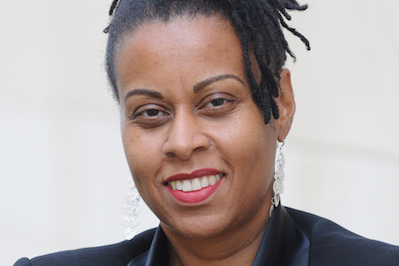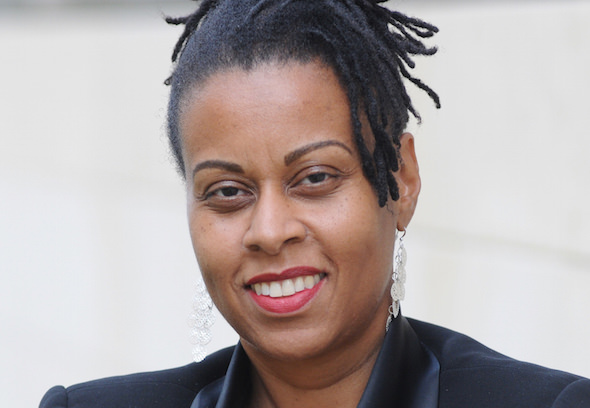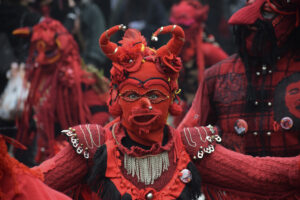Robert Scheer and Kali Nicole Gross Dissect a Startling Crime
The historian and author of "Hannah Mary Tabbs and the Dismembered Torso” tells Truthdig's editor in chief about tensions between black Americans and the criminal justice system today and in the past. Transcript added.

Author and historian Kali Nicole Gross. (Kali Nicole Gross)
In this week’s episode of “Scheer Intelligence,” Truthdig editor in chief Robert Scheer speaks with Kali Nicole Gross, Wesleyan University professor of African-American Studies and author of the recent book “Hannah Mary Tabbs and the Dismembered Torso.” The two discuss tensions between African-Americans and the criminal justice system today and in the past.
—Posted by Alexander Reed Kelly
Transcript:
Robert Scheer: Welcome to another edition of Scheer Intelligence. I’m Robert Scheer, and the intelligence comes from my guests. In this case, it’s Kali Nicole Gross, a professor of African-American studies at Wesleyan University and author of the new book, “Hannah Mary Tabbs and the Dismembered Torso.”
I have to say this ruined my last few days, reading this book, not because…It is brilliantly written and documented too, and in great detail, about a serial killer who happened to be a black woman in the late part of the 19th Century. It’s not at all depressing. I would recommend it as an interesting read, but it really takes you through…I think I can use the word ‘sordid’ here.
Kali N. Gross: Yes.
Robert Scheer: A sordid world, not just in terms of the principle character, but the world that she was forced to live in. Basically, a white world, a world in the period after the official end of slavery, but a continuation of a really oppressive life, basically centered in Philadelphia. I should say that you wrote a previous book that was very well received, on that same period, called “Colored Amazons: Crime, Violence and Black Women in the City of Brotherly Love, 1880-1910.”
You kind of own this area, and I figure it has something to do with your own education. I teach at the Annenberg School at USC, and I noticed you got your Doctorate and everything at the sister school, at University of Pennsylvania, right?
Kali N. Gross: Yes.
Robert Scheer: Not at the Annenberg school there.
How did you go from the academic specialty to what is truly a grisly subject of murder and serial killing? What is the purpose of the book?
Kali N. Gross: The purpose of the book? Well, to just start me off with a soft ball, why don’t you Robert? I’ll tell you, this book had its origins in my first book. I was doing research on black women in the criminal justice system in Philadelphia. This is the birth place of the penitentiary, in addition to being the birth place of the nation, and I came across this dusty scrapbook that was maintained by the guards at Eastern State Penitentiary. They, apparently, had taken newspaper clippings of their most infamous charges. I came across this case about a dismembered torso and all these crazy antics, and I just could not put it down.
Initially, the book just germinated out of my own interest. I was as curious and as titillated, I guess, as the 19th Century readers. I was just struck that there was a black woman at the heart of the story.
Robert Scheer: Maybe you could summarize that story?
Kali N. Gross: They actually organized it in order of how the story emerged, in spite of the fact that she had already been imprisoned there. A torso basically surfaces in this pond which is just outside of Philadelphia. It’s headless and limbless, this torso of a man, but the coloring is such that they’re not able to discern his race. This is a huge crisis for the investigators but also, really, the country at this point. It’s after slavery, it’s after Reconstruction. This is this period when we start to hear fears about miscegenation.
You know how there’s the documentary coming out, a film I think, about the Loving case in Virginia, that finally got rid of the ban on interracial marriage? This is the period where a lot of those bans started because they were concerned that race mixing would ultimately lead to this infiltration of white society.
When this torso surfaces, there’s a lot of anxiety about just who this victim is and how he came to this unfortunate end. The fact that they thought it was white man worked in his favor, because they really committed all their efforts to trying to solve the case.
One of the things that was harrowing in the course of doing the investigation about the case is that throughout the investigation and the trial, various body parts of other black folks surfaced. Once they decide that it’s not a part of this case, it just automatically fades into the background. There’s no investigation into what happened to them, how they met this unfortunate demise.
Robert Scheer: I do want to say about your book, because I’ve stressed that it’s about murder, it’s grisly, it’s also about a very strong woman who’s an improbable central character to observe. You do come away kind of respecting her, I think is the right word, or at least acknowledging her independence, her toughness. She’s a survivor of a long line back from slavery.
What is, to my mind, the incredible strength of this book, we have this fairy tale that denies, and the fairy tale is, “Sure we had slavery but that ended and we went on to a nice life. Why do we still have problems?” What your book does, because it’s really great history…The way you’ve woven the tale of this woman is you give us all the clippings, all the news reports, the texture of life, not in the deep south primarily, although people have come from the south, but there in the City of Brotherly Love.
Kali N. Gross: Exactly.
Robert Scheer: As you just mentioned, that’s where the penitentiary system started. It really goes to the basic question, first of all, are black people humans? Because you have a scene in there where somebody just describes, “They’re like the cattle, they don’t have souls.” A denial of the whole black church experience at all or relation to Christianity. Also, it makes very clear and in a detailed way the discrimination against black people, the isolation and so forth, after the end of slavery and in the north, and the contempt, the alienation and so forth. It actually takes a murder story and uses it in occasion to acquaint people with history with what was life like back then, and it’s not a pretty tale.
Kali N. Gross: No, and so in some respects this gets back to your first question, when you asked me what was the point or why did I want to write this book. It was…It started out with my fascination about this case but then the more I learned about it, it was this woman who was unlike any other black woman that I had read about in history, and I’m saying this as a historian. I was fascinated and intrigued, and I liked the fact that she was deeply flawed. There’s no…I hope that comes across in the book.
I tried to read her in the context of the period, and you’re right, it is ugly, it’s sordid, it’s violent. She comes into her womanhood during the civil war, this bloody violence that goes on in the country. Black women were particularly vulnerable to rape and brutalization. Even before that, she lived in a town that was notorious for a really brutal slave-owning family. There was this kind of violence in the society and in the culture already there as this back-drop, so that once you have slavery abolished, you have black folks trying to actualize their rights and enjoy their freedom, but it’s deeply fraught.
The whole country is scarred. There’s real trauma. She emerges with this little baby in tow that is mulatto, and the circumstances of that child’s origins are pretty murky. She is a survivor in many respects. She migrates up north, she marries a fairly good guy and tries to make a go of it, but she’s got real problems with anger, with violence. She uses it to create space for herself in a world where it usually didn’t exist for black women.
Robert Scheer: What I thought the value of the book, aside from that it’s a very good read, exciting and you want to know how it all goes, is it explains the deformity of life in America. That this country, particularly as regards to the issue of race and slavery, set out to deliberately deform, deny, the humanity of black people and others, Native Americans, and there’s a whole history, but particularly around the issue of slavery which then extends to life in the north in a very basic way.
There’s a modern significance to that because it deals with criminality, it deals with law enforcement, it deals with the behavior of authorities and even though you’re talking about distant events, there’s an echo in today’s policing issues.
Kali N. Gross: Yes.
Robert Scheer: When I look through some of your articles, you of course write about contemporary policing issues. I read those, and then I went back to your book and I had to remind myself we’re talking about a half century or more a distance, a century distance from those events.
Kali N. Gross: Right, and this is the other piece of the…The point of it is that I can’t tell you how astonished I was to see how closely, or how much, the events that were taking place with respect to policing and investigations and race, all the issues around brutality and racial profiling, how closely aligned they were to cases and ongoing issues today.
It was shocking for me, and in some respects I’m almost embarrassed to say that because as a historian, part of why I do what I do is because I want history to be a beacon, to speak to today, to resurrect these histories so that we can learn from them. I shouldn’t have been as surprised as I was but really, it was uncanny in certain respects but it was also instructive for me because it showed, early on, how the black community isolation from unbiased protection is related to crime in the black community.
Whenever we have these cases that arise, currently around shootings of unarmed black folks with white police officers, one of the push-backs right away is, “Well, why don’t they care about ‘black on black crime,’ or crimes that take place in the community?” My answer to that’s always, one, we do but also that the two issues are actually related. They’re both an artifice of black folks’ inability to benefit from unbiased criminal justice.
Robert Scheer: Yeah, that’s the heart of the whole book because the police are presumably there to protect people, and you have a lot of detail actually, how many there were and what their skillset was and limitations and so forth. Again, the modern echo is they’re alienated from a community, and so either you surround that community and then ignore it and let them kill each other, and what have you, and make life miserable for people who don’t want crime and are afraid or it, or you go in and you’re very aggressive.
There’s a phrase in your book, I don’t know if you intended it to have this modern application, called preventive policing. That’s a hot issue now in cities in America. They’re very actively using computers, databases and so forth as a project…I don’t want to be conspiratorial here, but Palantir is a company founded by the CIA that’s very involved with that. It happens here in Los Angeles, it happens in New Orleans, New York, and so forth.
It really has a lot to do with a very sophisticated racial profiling of people and then predicting who’s going to be a criminal, and then you go after them and you find evidence of crime. It’s a self-fulfilling prophecy. I was surprised that that shows up in your book, describing again a period of another Century.
Kali N. Gross: There’s also, in the back-drop, this idea that crime or criminality is inherent. That you have professional criminals, people who are inherently criminal. The police force and the detectives that are emerging are committed to a kind of muscular policing. They want to get ahead of it and do this preemptive, preventative surveillance of people who they believe might commit crimes, who have committed crimes in the past, or who…In some instances, they detain black folks who they didn’t believe belonged in certain places or who were carrying goods that they didn’t believe they owned.
They had police manuals that instructed them to detain folks who looked like they were from outside of the state. It left black folks vulnerable, but it also left poor whites vulnerable, and also immigrants. European immigrants were incredibly vulnerable to being detained and harassed too.
Robert Scheer: Yeah. Let me ask you, I didn’t get a sense from the book, was there any effort at all to have a police department that was somewhat more representative of the community? You mentioned when the immigrant populations were becoming more prominent in Philadelphia, there was some pressure on ..I guess you wouldn’t use the word police reform, but some challenge to the thing. Was there any sense at all about representation of race, gender, what have you?
Kali N. Gross: Still, there are these moments where you do actually have some black police officers in Philadelphia at this time. There’s not a huge amount of work done on them so it’s unclear to me whether they policed all communities or only black areas. I don’t have a good sense of what their numbers are. Also with respect to women…Women become involved with policing in a couple of key ways. You start to have middle class reformers being really concerned about the treatment, and particularly the vulnerability of women, in these all-male spaces.
Rape and sexual abuse and sexual harassment during confinement, and even in custody, was fairly rampant. They do start to install female matrons or police matrons or women who were there basically to receive female prisoners. They also started to work inside the prisons on women’s wards.
Robert Scheer: This is Scheer Intelligence. I’m speaking with author and professor, Kali Nicole Gross. We’ll be back after a short break.
We are back with Scheer Intelligence and my guest is Kali Nicole Gross, author of the book Hannah Mary Tabbs and the Disembodied Torso.
You were saying about the female aspect of this.
Kali N. Gross: Right, so they set…There were women who actually worked in stations and also within the penitentiary on female wards to help protect the women’s virtue when they were in custody. This could be an interesting segue into the other lurid aspects of this story which revolve around Tabbs’ sex life. This is the tail-end too of the Victorian period, where the ideals of chastity and morality, and certainly fidelity and marriage, were touted by everyone. African-American, as well as white people really believed in those values and strove to at least publicly represent them. For all intents and purposes, Hannah Mary Tabbs did just that.
One of the things that was also a shock about this case is that once they suss out the identity of this victim and they realize he’s involved in this adulterous relationship with this older woman, it really becomes a sensation. I was pretty surprised myself because as the investigators hone in on her and another suspect, and they start to suspect that her home serves as the crime scene, when they go and investigate, they actually find the victim’s clothes, or her lover’s clothes, are in the home that she also shared with her husband.
Initially, I couldn’t make head nor tails of it, like, “Well, did they work out some sort of arrangement?” We find out. I came across this pension record from the civil war, that it turned out he actually fought on the side of the colored troops, clearly, and had been injured. It said that he had been ruptured in the groin. I basically put together and speculated that he must’ve had some kind of performant problem and that she and he worked out this arrangement where he knew that she was engaging in these extra-marital affairs and seemed to tolerate it.
Robert Scheer: Quite an effort. Let me talk about this female character you have.
Kali N. Gross: Sure.
Robert Scheer: She typically would be a male character, except you’re following fact rather than fiction. She’s strong-willed, she takes a younger lover in this case, that seems to suit her needs. She intimidates people. She’s very aggressive and that’s not the image of the black woman coming out of slavery that one had. That one had the view of always being vulnerable and a victim and so forth. She made her own reality in which she takes charge, for better or worse.
Kali N. Gross: She does. I definitely was fascinated by her. I tried to be objective in writing the book, and I’m sure there are many points where I failed along the way. Yeah, she did a really good job at manipulating people. She knew how to present herself in the white world. She maintained good jobs, she demurred to white authority publicly. By all accounts she was a very good cook so she got lucrative positions and never had any trouble.
Within the black community, where she knew folks were isolated and couldn’t go to the police or count on protection in the same ways, she did, she relied on intimidation. She threatened people. She brutalized folks in her family, in her neighborhood, in her lover’s neighborhood. She was known as an all-around tough customer and that gave her a lot of room. People tended to steer clear and stay out of her way.
Robert Scheer: The character we’re talking about is Hannah Mary Tabbs. The book is “Hannah Mary Tabbs and the Dismembered Torso.” As I said at the beginning, it’s not…One of the good things about doing these podcasts, I feel compelled to read books and often they’re books I wouldn’t have read and this is one, by the title, that I would not have read, although I was familiar with your work a scholar. I soon then was not disappointed that it ends up actually having a great deal of heft, scholarly and historical heft. Actually, the question really is, how typical was this woman to write a book about, or was she just a hook for weaving a whole good, not only good, brilliant, account of life in that period? Or, were there other strong women, not just doing illegal things but were there other…Where’d she come from?
You said she worked in these white households, most often she deferred. The whole point really of the book is she couldn’t have gotten away with this if she was inflicting damage on white people, it was all black people.
Kali N. Gross: No.
Robert Scheer: That’s really a big point about the non-policing, and a good sense of the black community, which many people would argue continues to this day in terms of real safety. How typical was she of a kind of emerging female strength. You used the word ‘Amazons’ for your previous book, so maybe we should talk about that book as well.
Kali N. Gross: Right, so my first book looked at the ways that black women were caricatured as being criminal, violent, dangerous, fiendish. That they were these Amazons that basically robbed white men of life, liberty and property. That character actually came up to camouflage the fact that there were white men who were going after black prostitutes who would manipulate the race code to rob the men, and because it was such a taboo for white men to be cavorting with black women, they tended not to press charges. Even when they did, the judges would usually throw the cases out, assuming that the white men who wanted to sleep with black women got what they deserved.
When newspapers covered those cases, instead of talking about these white men going to black women, would be prostitutes, and ending up being the victims of badger games, they stigmatized and maligned the black women as these colored Amazons that just grabbed these men off the street and took money out of their pockets.
Anyway, the point about talking about that caricature is that is was sort of a myth, but it haunted all black women who went before the justice system. What’s also ironic about Tabbs’ case, is that even though that she actually is violent and does a lot of destructive things, she’s able to manipulate the white public gaze in such a way so they actually see her as a woman who has some sort of respectability. They just can’t believe that she could’ve committed the crime. A part of that has to do with her racial miming. She turns on her southern accent, she demurs to white authority, she doesn’t look them in the eye. She knows how to manipulate and play white people.
With respect to where she comes from, I think that she really is a combination of the mundane and the extraordinary aspects of black womanhood at this time. On the face of it, she was not dissimilar from masses of black women who migrated north into Philadelphia at this time. Like 90% of working black woman, she worked as a domestic. She was married. She was raising her “niece”. On the face of it, she wasn’t particularly extraordinary at all and yet this case revealed this whole other life and world that she had created.
Robert Scheer: The strength of your book is in its complexity. These are not stereotypical characters. People who are written about as complex, their origins, their make up, even their pigmentation varies, there’s no such thing as just black or something. One distinction that I found very instructive, is that the slavery did not stop being a force, that the experience of blacks in America was permanently, at least up to the present, but certainly during the period you describe, altered to form…Whatever the right word is, distorted, by slavery and it continues. You’ve just referenced it now, there’s a way of looking at white people.
I once did a profile of Willy Brown who went on to be one of the top politicians in California and Speaker of the Assembly and Mayor of San Francisco, and all that. He described growing up in Mineola, Texas, and just the nuances he could … He would watch his father step down into the street on a narrow sidewalk to let white teenagers pass. That sort of thing. While it in the day of segregation, but you never went to a movie theater that was integrated.
You’re dealing, however, with Philadelphia not Mineola, Texas, and yet you’re describing a pretty rigid racial distortion in the experience of a black person growing up in the City of Brotherly Love.
Kali N. Gross: One of the things that folks forget is that Philadelphia had, at one time, slavery as well. During the colonial period, Philadelphia, like every other colony including New York and all these other northern territories, they all had slavery. It isn’t until after the founding of the country that they start to shift and gradually abolish slavery. What happens is that once they abolish slavery, they automatically make the prison system more robust. It’s not a coincidence that at the same time you have in Pennsylvania this 1780 Act for the gradual abolition of slavery, that you have, on its heels in 1790, the establishment of the nation’s first penitentiary.
Robert Scheer: Yeah.
Kali N. Gross: Philadelphia has this reputation for abolitionism and Quaker roots and all these high-minded ideals around liberty and egalitarianism, but it was marred by the same racism that I think you’re pointing out. I do understand one thing about…When we think about slavery in this country, it definitely has impacted blackness and the experience of black people, but for me it’s deformed whites in the country as well.
The behaviors that we see exhibited by the police, the brutality, the harassment, even the violence of the justice system, also to me is based on the ways that they too have been marred by this institution.
Robert Scheer: I want to get at two themes that are dealt with in the book, and again in a complicated way, and one is the whole role of sex. That’s the subtext of a lot of these issues in the treatment of black woman as sex objects, their availability. Going back to the old case of Thomas Jefferson, it’s one of the things…He was probably one of the better individuals around among our founders, and yet…Maybe he even had a less oppressive relationship, but it’s just, boom, it’s there. It’s there. I wonder what insight you gained into all of this, and again, its effects on whites as well as blacks.
Kali N. Gross: There’s a way in which black women have concealed their sexuality at this time period because they were so vulnerable to rape and sexual assault, and this is in the north and the south, particularly as domestics where they were working in white homes and they knew that if something happened, no one was going to be punished. They weren’t going to get anybody convicted of their rape in the justice system, so they tended to adopt this strategy where they tried to conceal sexuality.
Some historians have written about this. Darlene Clark Hine calls it the ‘cultural dissemblance’. They try to conceal their sexuality as a way to stave off these attacks. Normally we don’t have a lot of information about how black women themselves, behind closed doors, imagine or understood themselves or their sexuality. That’s part of why I was so intrigued by this case also that, in spite of the respectability politics, in spite of the dangers, and the customary efforts that black women went to to conceal their sexuality and to push back against the idea that they were low, common women, that they were all prostitutes and unrapeable, is that do have this women taking charge in way and seeking pleasure nonetheless.
Robert Scheer: We did run out of time. That’s it for Scheer Intelligence. The book is “Hannah Mary Tabbs and the Dismembered Torso.” I want to make clear, the subject is depressing, the read is not.
Kali N. Gross: Thank you.
Robert Scheer: It is detailed, it’s informative, it is extremely well written, so I don’t want to turn anybody off. If you want to understand this country and the 40 years or 50 years after the civil war, and understand it in the context of Philadelphia, it’s probably the best thing, or it’s the best thing that I know of, that you can read.
Kali N. Gross: Thank you.
Robert Scheer: A really important work. Written by Kali Nicole Gross, an academic, a distinguished academic. The producers for Scheer Intelligence are Joshua Scheer and Rebecca Mooney, the engineers at KCRW are Mario Diaz and Kat Yore. Thanks to WNPR in Hartford. See you next time.
Independent journalism is under threat and overshadowed by heavily funded mainstream media.
You can help level the playing field. Become a member.
Your tax-deductible contribution keeps us digging beneath the headlines to give you thought-provoking, investigative reporting and analysis that unearths what's really happening- without compromise.
Give today to support our courageous, independent journalists.






You need to be a supporter to comment.
There are currently no responses to this article.
Be the first to respond.